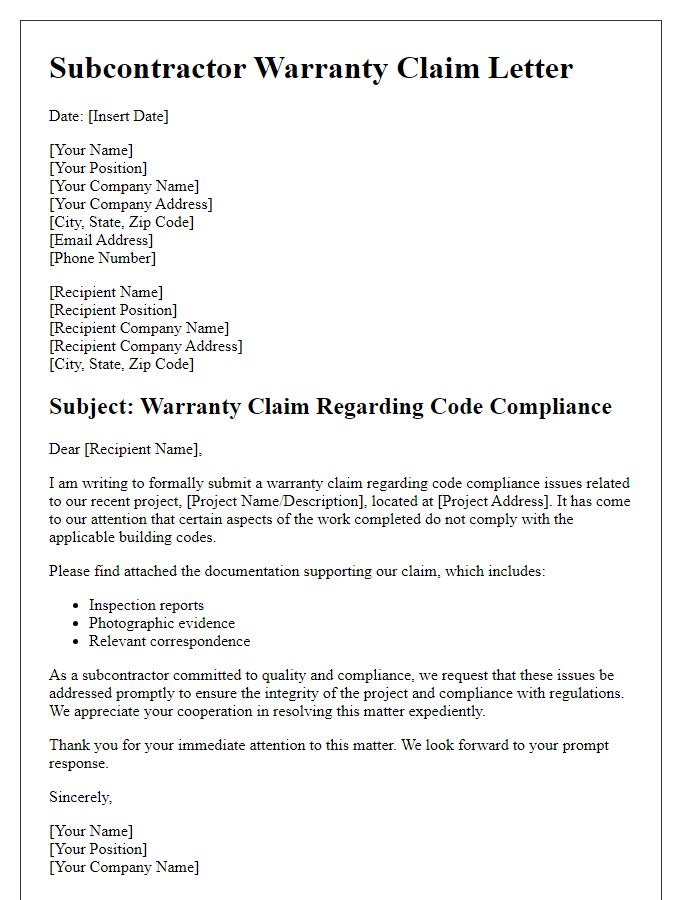Navigating the intricacies of a warranty claim can be daunting, especially when you're working with subcontractors. Understanding the nuances of warranty agreements is crucial for protecting your investments and ensuring smooth project completion. In this article, we'll break down the essential elements of a letter template designed specifically for subcontractor warranty claims. Ready to simplify the process? Let's dive in!

Clear identification of parties involved
A subcontractor warranty claim must clearly identify all parties involved. This includes the primary contractor, the subcontractor, and the warranty provider (if different). For example, the primary contractor could be XYZ Construction, operating at 123 Main Street, City, State. The subcontractor might be ABC Electrical Services, located at 456 Elm Street, City, State. The warranty provider could be DEF Insurance Company, based at 789 Pine Street, City, State. Accurate identification includes full names, business addresses, and contact information for each party. This clarity ensures that the claim is processed efficiently and that all involved parties understand their roles and responsibilities in the warranty claim process.
Specifics of the warranty claim
A subcontractor warranty claim involves specific details regarding the agreements made under the contract. The claim typically outlines the scope of work, including installation or construction services conducted by the subcontractor, often involving unique materials or methods. Relevant dates, such as the contract start date, completion date, and the date of the issue arising, are crucial. Documentation, including photographs of defective work, inspections, and communication records, is essential for substantiating the claim. The warranty terms, delineating coverage duration--usually one to five years after project completion--and conditions that trigger coverage, must be highlighted. Consideration of local building codes and industry standards provides additional context for the claim. Finally, detailing the resolution sought, whether it's repair, replacement, or a refund, outlines the next steps in the claims process.
Relevant project details
A subcontractor warranty claim should include crucial project details such as project name, location (specific address or site name), contract number, and date of completion. The project name identifies the undertaking, while the location pinpoints where the work was performed (for example, 123 Main St, Springfield). The contract number establishes the relationship and agreement specifics, and the date of completion confirms when the project reached its final stage. Essential details may also encompass a description of the work performed (for instance, plumbing installation or electrical wiring), the warranty duration (such as one year from completion), and the nature of the claim (e.g., defective materials or workmanship issues). Documentation (like photographs or inspection reports) can support the claim, providing compelling evidence of the problem encountered.
Description of the defect or issue
Defective roofing installation can lead to significant water damage within residential properties in rainy climates, especially in regions like Seattle, Washington. Improperly aligned shingles can create gaps allowing water infiltration during heavy rainfall, which may exceed 3 inches per hour. This issue can compromise the integrity of the underlying structure, including wooden beams and insulation, resulting in mold growth and costly repairs. The failure of materials, such as an inferior synthetic underlayment, may contribute to long-term performance problems. Timely intervention is essential to prevent further structural complications and protect homeowner investments.
Requested resolution or action
In warranty claims for subcontracting work, documentation is crucial for asserting rights and outlining necessary actions. A detailed description of the defective work, including specific issues encountered during the install phase, is essential. Include relevant dates when the work was completed or discovered to be defective, as these can impact the warranty coverage period. Attach supporting documents such as photographs of the defects, invoices for the subcontracted work, and any previous correspondence regarding the issue. Clearly state the desired resolution, whether it involves repair, replacement, or financial compensation, to guide the subcontractor on how to proceed effectively. Prompt feedback and resolution are paramount to maintain project timelines and ensure compliance with contractual obligations.
Letter Template For Subcontractor Warranty Claim Samples
Letter template of subcontractor warranty claim for defective materials.

Letter template of subcontractor warranty claim regarding code compliance.

Letter template of subcontractor warranty claim for performance deficiencies.











Comments